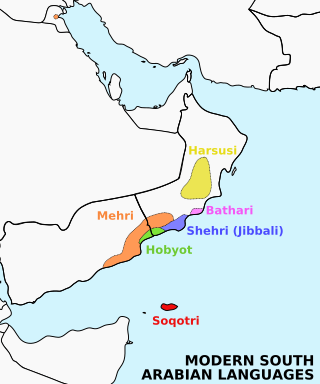| Mehri | |
|---|---|
| Pronunciation | [mɛhri] |
| Native to | Yemen, Oman, Saudi Arabia |
| Ethnicity | Mehri |
Native speakers | 230,000 (2020)[1] |
| Arabic alphabet | |
| Language codes | |
| ISO 639-3 | gdq |
| Glottolog | mehr1241 |
| ELP | Mehri |
 Mehri | |
Mehri or Mahri (مهريّت) [Roman Transliteration: Mahrīyyt] is the most spoken of the Modern South Arabian languages (MSALs), a subgroup of the Semitic branch of the Afroasiatic family. It is spoken by the Mehri tribes, who inhabit isolated areas of the eastern part of Yemen, western Oman, particularly the Al Mahrah Governorate, with a small number in Saudi Arabia near the Yemeni and Omani borders. Up to the 19th century, speakers lived as far north as the central part of Oman.[2]
Mehri and its sister MSALs were spoken in the southern Arabian Peninsula before the spread of Arabic along with Islam in the 7th century CE. Today it is also spoken by Mehri residents in Qatar and the United Arab Emirates, as well as in Kuwait by guest workers originally from South Arabia, as well as nationals with a South Arabian heritage.
Given the dominance of Arabic in the region over the past 1400 years and the frequent bilingualism with Arabic among Mehri speakers, Mehri is at some risk of extinction. It is primarily a spoken language, with little existing vernacular literature and almost no literacy in written Mehri among native speakers.
- ^ Mehri at Ethnologue (25th ed., 2022)

- ^ Walter Dostal (1967). Die Beduinen in Südarabien. Eine ethnologische Studie zur Entwicklung der Kamelhirtenkultur in Arabien (in German). Vienna: Ferdinand Berger and Söhne OHG. p. 133. fig. 19